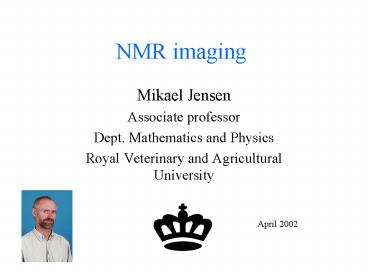NMR imaging - PowerPoint PPT Presentation
1 / 47
Title:
NMR imaging
Description:
NMR imaging. Mikael Jensen. Associate professor. Dept. Mathematics ... http://rad.usuhs.mil/rad/iong/homepage.html. End of lecture. Bloch. Purcell. Lauterbur ... – PowerPoint PPT presentation
Number of Views:54
Avg rating:3.0/5.0
Title: NMR imaging
1
NMR imaging
- Mikael Jensen
- Associate professor
- Dept. Mathematics and Physics
- Royal Veterinary and Agricultural University
April 2002
2
Why imaging
- Non-destructive
- Dynamic
- In-vivo
- or
- Destructive
- Static
- Once in a lifetime
3
Medical use
4
Veterinary use
- Røntgen
- Ultralyd
- Termografi
5
Penetrating radiation
- X-rays (20-200 keV)
- Gamma (80-511 keV)
- Radiofreqency 63 MHz
- Light(near infra-red)
- Ultrasound
6
X-ray
- Show differences in electron density
- Small inherent contrast in soft tissue
- Many photons means good S/N ratio
- Good geometric resolution
- Planar ( projections )
- Can be used for tomography ( CT-scan)
- Uses ionizing radiation
7
Radio-isotopes (gamma radiation)
- Function more than anatomy
- Totally dependent on nature of tracer
- Few photons, high contrast
- Poor gometric resolution
- Uses ionizing radiation
8
Ultrasound
- Shows differences in sound velocity and density
- Tissue borderlines
- Air-filled cavities creates shadows
- Real-time
- Cheap and safe
- Interactive
Egentlig Forskel i akustisk impedans !
9
NMR imaging (MRI)
- No ionising radiation
- Large inherent contrast in soft tissue
- Can demonstrate both anatomy and function
- Good geometrical resolution
- Expensive
- Restricted acces to patient during exam
10
Very good web introduction to MRI
http//www.cis.rit.edu/htbooks/mri/inside.htm
Go and read it !
11
NMR imaging
Frequency ? B For protons ? 42 MHz /
Tesla Wawelength at 1 Tesla ? Wawelength c/f
7 meter !
?
12
External magnetic field necessary for NMR
S
z
Bo
y
N
x
By convention we choose z axis along Bo
13
We need nuclei with magnetic moment for NMR
Could be Hydrogen in water (protons)
14
Larmor condition
E h ? B E h f
f ? B (Larmor condition)
?(proton) 42 MHz/ Tesla
When the energy of the photon matches the energy
difference between the two spin states an
absorption of energy occurs. In the NMR
experiment, the frequency of the photon is in the
radio frequency (RF) range. In NMR spectroscopy,
is between 60 and 800 MHz for hydrogen nuclei.
In clinical MRI, is typically between 15 and 80
MHz for hydrogen imaging.
15
Boltzman Statistics
At room temperature, the number of spins in the
lower energy level, N, slightly outnumbers the
number in the upper level, N-. Boltzmann
statistics tells us that N-/N e-E/kT. E is
the energy difference between the spin states k
is Boltzmann's constant, 1.3805x10-23 J/Kelvin
and T is the temperature in Kelvin.
1.000.000
1.000.001
16
T1 relaxation
The time constant which describes how MZ returns
to its equilibrium value is called the spin
lattice relaxation time (T1). The equation
governing this behavior as a function of the time
t after its displacement is Mz Mo ( 1 -
e-t/T1 )
17
T2 relaksation
The time constant which describes the return to
equilibrium of the transverse magnetization, MXY,
is called the spin-spin relaxation time, T2. MXY
MXYo e-t/T2
18
Bloch equations
19
Free induction decay (FID)
Short RF pulse at Larmor frequency
90o
Detected RF signal from nuclei
20
Fourier transform af FID
F
tid
frekvens
F-1
(sted)
21
NMR in organic chemistry
CH3CH2OH Also known as Ethanol
1951
Frequency alias chemical shift ?
1991
22
MRI imaging is broadband
- In chemical NMR typical resolution (linewidth) is
0.1 ppm - Chemical shifts are of the order of 1- 10 ppm
- In imaging we have inhogeneous magnetic fields
- In imaging we use frequncy to encode spatial
position - Typical space coding 100 Hz/mm or 500 ppm/mm
f
f
23
Pulsewidth and flipangle
90o
180o
270o
pw
2pw
3pw
24
Spin echo
TE/2
TE/2
90o
180o
25
Gradient in magnetic field
B Bo Gx x Bo 1,5 T Gx 25 mT
/cm Frequency coding df/dx Gx ? 1 kHz /cm
100 Hz/mm
FFT ?
time
Gradient
f
26
Imaging of one slice
y
x
Gz
z
27
Slice selected echo
90o
180o
Only signal from slice
Gz
Normally chosen as z-direction
28
Read-out gradient
90o
180o
Gz
Gx
29
Phase encoding gradient
90o
180o
Gz
Gy
Gx
30
Repeat this, and you got the image
m data points
2D FFT
m
n
n repetitions
31
Another way to do imaging
Select one slice ! Do many experiments with
different directions of readout gradient
32
Back projection
33
Filtered back projection
Radon transformation ( MRI, CT, PET, Spect
.) S.R. Deans, S. RoderickThe Radon Transform
and Some of its Applications.Wilwy, New York1983
34
Slice selective MRI by back projection
Many values
Repeat for many angles
Many values
35
Multi slice imaging
36
Inversion recovery imaging
37
MRI hardware
38
Magnet
B0
0.015 0.3 Tesla Resistive 0.5 3 Tesla
Superconducting
39
Gradients
40
Safety
- Static magnetic field
- No metal objects
- Shielding
- B lt 3 Tesla
- RF power deposition
- Deposited power lt 4 W / Kg
- No hot spots
- B lt 3 Tesla (f lt 130 MHz )
41
Images!
42
Lumbar spine MRI
Prolaps
Normal
Malignancy ?
43
Liver
Arrows
point to multiple lesions in the liver
demonstrating metastases.
44
Tværsnit af rygmarv hos rotte
45
Hjernen af en stær (in vivo)
46
Good image archivesNORTHEAST WISCONSIN MRI
CENTERMR IMAGES
http//www.newmri.com/humanbo2.htm
RADIOLOGIC ANATOMY BROWSER http//rad.usuhs.mil/
rad/iong/homepage.html
47
End of lecture
Bloch
Purcell
Lauterbur































